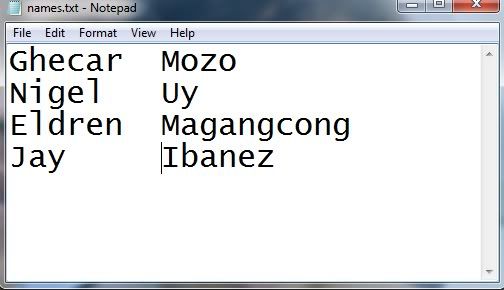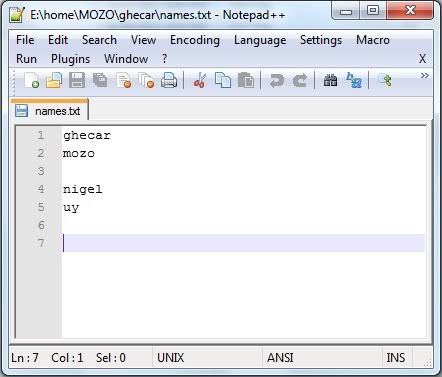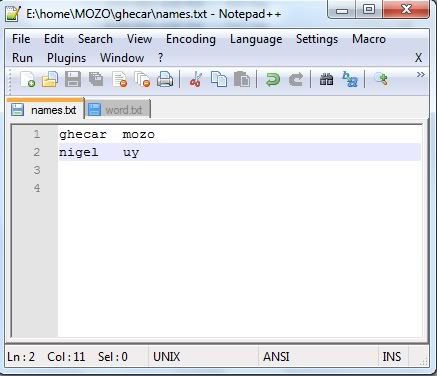|
|
Sponsored Content
Top Forums
UNIX for Dummies Questions & Answers
format values in a text file using cat command
Post 302551298 by kpopfreakghecky on Tuesday 30th of August 2011 04:08:15 AM
|
|
10 More Discussions You Might Find Interesting
1. Shell Programming and Scripting
Hello,
So I sorted my file as I was supposed to:
sort -n -r -k 2 -k 1 file1 | uniq > file2
and when I wrote
> cat file2
in the command line, I got what I was expecting, but in the script itself
...
sort -n -r -k 2 -k 1 averages | uniq > temp
cat file2
It wrote a whole... (21 Replies)
Discussion started by: shira
21 Replies
2. UNIX for Dummies Questions & Answers
Hello ,
I am newbie to UNIX platform .
I have read that there are two ways of creating files that is using
1.) Cat 2.) touch .
With Cat Command i am unable to create a File , i is saying No file or Directory exists
I logged in with root as user .
please help (7 Replies)
Discussion started by: Ravi Pavanv
7 Replies
3. Shell Programming and Scripting
I have high values (such as ÿÿÿÿ) in a text file contained in an Unix AIX server. I need to identify all the records
which are having these high values and also get the position/column number in the record structure if possible. Is there
any Unix command by which this can be done to :
1.... (5 Replies)
Discussion started by: devina
5 Replies
4. UNIX for Dummies Questions & Answers
Hi,
While editing a small text file with cat command i pressed ctrl-d to send eof, instead of coming out of cat command it echoed ^D to the screen. Same thing is happening to ctrl-c. After googling i found this is because of trap.
The problem is i m stuck in editing mode and cannot get the... (3 Replies)
Discussion started by: TITANIUM
3 Replies
5. Shell Programming and Scripting
I have results from some statistical analyses.
The format of the results are as given below:
I want to select lines that have a p-value (last column) less than 0.05 from all the results files (*.results) and cat to a new results file.
It would be very nice if a new column is added that tells... (2 Replies)
Discussion started by: genehunter
2 Replies
6. Shell Programming and Scripting
Hi.
I'm just wondering how can I read variable text files through cat command.
I made a shell script to count frequency of words and array them with variable conditions. It's only working for one file that I wrote in script now. But I want to make it working for every text file when I execute... (2 Replies)
Discussion started by: rlaxodus
2 Replies
7. UNIX for Dummies Questions & Answers
I use the cat command to concatenate text files, but one of the rows I was expecting doesn't display in the output file. Is there a verbose mode\logging mechanism for the cat command to help me investigate where the lines I was expecting are going??
cat 7760-001_1_*_06_*.txt | grep -v... (1 Reply)
Discussion started by: Xin Xin
1 Replies
8. Shell Programming and Scripting
I have a file containing multiple values, some of them are pipe separated which are to be read as separate values and some of them are single value all are these need to store in variables.
I need to read this file which is an input to my script
Config.txt
file name, first path, second... (7 Replies)
Discussion started by: ketanraut
7 Replies
9. Shell Programming and Scripting
I have a directory that is restricted and I cannot just copy the files need, but I can cat them and redirect them to a new directory. The files all have the date listed in them. If I perform a long listing and grep for the date (150620) I can redirect that output to a text file. Now I need to... (5 Replies)
Discussion started by: trigger467
5 Replies
10. UNIX for Beginners Questions & Answers
How to change the format of an excel from exponential to text through UNIX command
We have a pipe delimited file in which one particular A column is a combination of number+text and while converting into
excel using tr command it is generating a exponential data for the A column.
Kindly... (2 Replies)
Discussion started by: AbiramiRaja
2 Replies
LEARN ABOUT DEBIAN
imgsizer
IMGSIZER(1) IMGSIZER(1) NAME
imgsizer - automatically splice in height and width params for HTML IMG tags SYNOPSIS
imgsizer [-d file] [--document-root file] [-h file] [--help file] [-n] [--no-overwrite] [HTMLFile] [-v file] [--version] OPTIONS
Display version information and exit. Display usage information. Directory where absolute image filenames (i.e, ones which contain a leading "/") may be found. -n, --no-overwwrite, .SH DESCRIPTION The imgsizer script automates away the tedious task of creating and updating the extension HEIGHT and WIDTH parameters in HTML IMG tags. These parameters help many browsers (including the Netscape/Mozilla family) to multi-thread image loading, instead of having to load images in strict sequence in order to have each one's dimensions available so the next can be placed. This generally allows text on the remainder of the page to load much faster. This script will try create such attributes for any IMG tag that lacks them. It will correct existing HEIGHT and WIDTH tags unless either contains a percent (%) sign, in which case the existing dimensions are presumed to be relative and left unaltered. This script may be called with no arguments. In this mode, it filters HTML presented on stdin to HTML (unaltered except for added or cor- rected HEIGHT and WIDTH attributes) on stdout. If called with file arguments, it will attempt to transform each file in place. Each argu- ment file is not actually modified until the script completes a successful conversion pass. The -d <directory> option sets the DocumentRoot, where images with an absolute filename (i.e., ones which contain a leading "/") may be found. If none is specified, the DocumentRoot defaults to the current working directory. The -n (no-overwrite) opion prevents the program from overwriting existing width and height tags if both are present. Additional options may also be specified in the environmental variable "IMGSIZER". For example, to avoid typing "imgsizer -d /var/www/docs" each time imgsizer is invoked, you might tell sh (or one of its descendants): IMGSIZER="-d /var/www/docs"; export IMGSIZER or, if you use csh: setenv IMGSIZER "-d /var/www/docs" This script is written in Python, and thus requires a Python interpreter on the host system. It also requires either the identify(1) utili- ty distributed in the open-source ImageMagick suite of image-display and manipulation tools, or a modern version of file(1) and rdjpg- com(1). These utilities are used to extract sizes from the images; imgsizer itself has no knowledge of graphics formats. The script will handle any image format known to identify(1) including PNG, GIF, JPEG, XBM, XPM, PostScript, BMP, TIFF, and anything else even remotely likely to show up as an inline image. NOTE
The -q, -l, and -m options of the 1.0 versions are gone. What they used to do has been made unnecessary by smarter logic. BUGS
The code uses regular expressions rather than true HTML/XML parsing. Some perverse but legal constructions, like extraneous space within quoted numeric attributes, will be mangled. AUTHOR
Originally created by Eric S. Raymond <esr@thyrsus.com>. Additional code contributed by Erik Rossen, Michael C. Toren <michael@toren.net>, and others. For updates, see <http://www.catb.org/~esr: http://www.catb.org/~esr> SEE ALSO
identify(1), file(1), rdjpgcom(1). IMGSIZER(1)


 )
)
